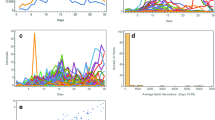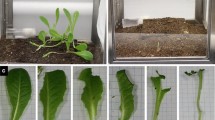Abstract
Extrapolation of predator functional responses from laboratory observations to the field is often necessary to predict predation rates and predator-prey dynamics at spatial and temporal scales that are difficult to observe directly. We use a spatially explicit individual-based model to explore mechanisms behind changes in functional responses when the scale of observation is increased. Model parameters were estimated from a predator-prey system consisting of the predator Delphastus catalinae (Coleoptera: Coccinellidae) and Bemisia tabaci biotype B (Hemiptera: Aleyrodidae) on tomato plants. The model explicitly incorporates prey and predator distributions within single plants, the search behavior of predators within plants, and the functional response to prey at the smallest scale of interaction (within leaflets) observed in the laboratory. Validation revealed that the model is useful in scaling up from laboratory observations to predation in whole tomato plants of varying sizes. Comparing predicted predation at the leaflet scale, as observed in laboratory experiments, with predicted predation on whole plants revealed that the predator functional response switches from type II within leaflets to type III within whole plants. We found that the magnitude of predation rates and the type of functional response at the whole plant scale are modulated by (1) the degree of alignment between predator and prey distributions and (2) predator foraging behavior, particularly the effect of area-concentrated search within plants when prey population density is relatively low. The experimental and modeling techniques we present could be applied to other systems in which active predators prey upon sessile or slow-moving species.





Similar content being viewed by others
References
Abrams PA (1982) Functional responses of optimal foragers. Am Nat 120:382–390. doi:10.1086/283996
Bailey VA, Williams EJ, Nicholson AJ (1962) Interaction between hosts and parasites when some host individuals are more difficult to find than others. J Theor Biol 3:1–18. doi:10.1016/s0022-5193(62)80002-2
Bell WJ (1991) Searching behaviour: the behavioural ecology of finding resources. Chapman and Hall animal behaviour series, 1st edn. Chapman and Hall, London
Berryman A (1999) Theoretical foundations of biological control. In: Hawkins BA, Cornell HV (eds) Theoretical approaches to biological control. Cambridge University Press, Cambridge, pp 3–21
Berryman AA, Hawkins BA (2006) The refuge as an integrating concept in ecology and evolution. Oikos 115:192–196. doi:10.1111/j.0030-1299.2006.15188.x
Biesinger Z, Haefner JW (2005) Proximate cues for predator searching: a quantitative analysis of hunger and encounter rate in the ladybird beetle, Coccinella septempunctata. Anim Behav 69:235–244. doi:10.1016/j.anbehav.2004.02.023
Bolker BM (2008) Ecological models and data in R. Princeton University Press, Princeton
Bolker BM (2013) emdbook: ecological models and data in R, R package version 1.3.4. Retreived from http://cran.r-project.org/package=emdbook
Bond AB (1983) The foraging behavior of lacewing larvae on vertical rods. Anim Behav 31:990–1004. doi:10.1016/s0003-3472(83)80004-9
Byrne DN, Bellows TS (1991) Whitefly biology. Annu Rev Entomol 36:431–457
Cockshull KE, Ho LC, Fenlon JS (2001) The effect of the time of taking side shoots on the regulation of fruit size in glasshouse-grown tomato crops. J Hortic Sci Biotechnol 76:474–483
Cook RM, Hubbard SF (1977) Adaptive searching strategies in insect parasites. J Anim Ecol 46:115–125. doi:10.2307/3950
Cordoleani F, Nerini D, Morozov A, Gauduchon M, Poggiale J-C (2013) Scaling up the predator functional response in heterogeneous environment: when Holling type III can emerge? J Theor Biol 336:200–208. doi:10.1016/j.jtbi.2013.07.011
Costamagna AC, Landis DA (2011) Lack of strong refuges allows top-down control of soybean aphid by generalist natural enemies. Biol Control 57:184–192. doi:10.1016/j.biocontrol.2011.03.006
Costamagna AC, McCornack BP, Ragsdale DW (2013) Within-plant bottom-up effects mediate non-consumptive impacts of top-down control of soybean aphids. PLoS One 8:e56394–e56394. doi:10.1371/journal.pone.0056394
De Barro PJ, Liu S-S, Boykin LM, Dinsdale AB (2011) Bemisia tabaci: a statement of species status. Annu Rev Entomol 56:1–19. doi:10.1146/annurev-ento-112408-085504
Englund G, Leonardsson K (2008) Scaling up the functional response for spatially heterogeneous systems. Ecol Lett 11:440–449. doi:10.1111/j.1461-0248.2008.01159.x
Englund G, Ohlund G, Hein CL, Diehl S (2011) Temperature dependence of the functional response. Ecol Lett 14:914–921. doi:10.1111/j.1461-0248.2011.01661.x
Gerling D, Alomar O, Arno J (2001) Biological control of Bemisia tabaci using predators and parasitoids. Crop Prot 20:779–799
Guershon M, Gerling D (1999) Predatory behavior of Delphastus pusillus in relation to the phenotypic plasticity of Bemisia tabaci nymphs. Entomologia Experimentalis Et Applicata 92:239–248
Hassell MP (1980) Foraging strategies, population-models and biological control: a case study. J Anim Ecol 49:603–628. doi:10.2307/4267
Heinz KM, Parrella MP (1994) Biological control of Bemisia argentifolii (Homoptera, Aleyrodidae) infesting Euphorbia pulcherrima—evaluations of releases of Encarsia luteola (Hymenoptera, Aphelinidae) and Delphastus pusillus (Coleoptera, Coccinellidae). Environ Entomol 23:1346–1353
Heinz KM, Brazzle JR, Parrella MP, Pickett CH (1999) Field evaluations of augmentative releases of Delphastus catalinae (Horn) (Coleoptera : Coccinellidae) for suppression of Bemisia argentifolii Bellows & Perring (Homoptera: Aleyrodidae) infesting cotton. Biol Control 16:241–251
Hemerik L, Yano E (2011) Scaling up from individual behaviour of Orius sauteri foraging on Thrips palmi to its daily functional response. Popul Ecol 53:563–572. doi:10.1007/s10144-011-0270-9
Hodek I, Honek A, Van Emden HF (2012) Ecology and behaviour of the ladybird beetles (Coccinellidae)
Hoelmer KA, Osborne LS, Yokomi RK (1993) Reproduction and feeding behavior of Delphastus pusillus (Coleoptera, Coccinellidae), a predator of Bemisia tabaci (Homoptera, Aleyrodidae). J Econ Entomol 86:322–329
Holling CS (1961) Principles of insect predation. Annu Rev Entomol 6:163–182. doi:10.1146/annurev.en.06.010161.001115
Ide T, Suzuki N, Katayama N (2007) The use of honeydew in foraging for aphids by larvae of the ladybird beetle, Coccinella septempunctata L. (Coleoptera: Coccinellidae). Ecological Entomology 32:455–460. doi:10.1111/j1365-2311.2007.00896.x
Juliano SA (2001) Nonlinear curve fitting: predation and functional response curves. In: Scheiner SM, Gurevitch J (eds) Design and analysis of ecological experiments, Second edn. Oxford University Press, New York, pp 178–196
Lin LI-K (1989) A concordance correlation coefficient to evaluate reproducibility. Biometrics 45:255–268
Liu TX, Stansly PA (1999) Searching and feeding behavior of Nephaspis oculatus and Delphastus catalinae (Coleoptera: Coccinellidae), predators of Bemisia argentifolii (Homoptera: Aleyrodidae). Environ Entomol 28:901–906
Liu TX, Oetting RD, Buntin GD (1993) Distribution of Trialeurodes vaporariorum and Bemisia tabaci (Homoptera, Aleyrodidae) on some greenhouse-grown ornamental plants. J Entomol Sci 28:102–112
Logan JD, Wolesensky W (2007) Accounting for temperature in predator functional responses. Nat Resour Model 20:549–574
Lundgren JG (2009) Nutritional aspects of non-prey foods in the life histories of predaceous Coccinellidae. Biol Control 51:294–305. doi:10.1016/j.biocontrol.2009.05.016
Madden LV, Hughes G, Fvd B (2007) The study of plant disease epidemics. American Phytopathological Society, St. Paul
Montserrat M, Albajes R, Castañé C (2000) Functional response of four Heteropteran predators preying on greenhouse whitefly (Homoptera: Aleyrodidae) and western flower thrips (Thysanoptera: Thripidae). Environ Entomol 29:1075–1082. doi:10.1603/0046-225X-29.5.1075
Morozov AY (2010) Emergence of Holling type III zooplankton functional response: bringing together field evidence and mathematical modelling. J Theor Biol 265:45–54. doi:10.1016/j.jtbi.2010.04.016
Musser FR, Shelton AM (2003) Factors altering the temporal and within-plant distribution of coccinellids in corn and their impact on potential intra-guild predation. Environ Entomol 32:575–583
Nachman G (2001) Predator-prey interactions in a nonequilibrium context: the metapopulation approach to modeling “hide-and-seek” dynamics in a spatially explicit tri-trophic system. Oikos 94:72–88. doi:10.1034/j.1600-0706.2001.11314.x
Nachman G (2006) A functional response model of a predator population foraging in a patchy habitat. J Anim Ecol 75:948–958. doi:10.1111/j.1365-2656.2006.01114.x
Oaten A (1977) Transit-time and density-dependent predation on a patchily distributed prey. Am Nat 111:1061–1075. doi:10.1086/283238
Oaten A, Murdoch WW (1975) Functional response and stability in predator-prey systems. Am Nat 109:289–298. doi:10.1086/282998
Obrycki JJ, Kring TJ (1998) Predaceous Coccinellidae in biological control. Annu Rev Entomol 43:295–321
Okuyama T (2013) On selection of functional response models: Holling’s models and more. BioControl 58:293–298. doi:10.1007/s10526-012-9492-9
O’Neil RJ (1989) Comparison of laboratory and field measurements of the functional response of Podisus maculiventris (Heteroptera: Pentatomidae). J Kans Entomol Soc 62:148–155
O’Neil RJ (1990) Functional response of arthropod predators and its role in the biological control of insect pests in agricultural systems. In: Baker RR, Dunn PE (eds) New directions in biological control : alternatives for suppressing agricultural pests and diseases. Proceedings of a UCLA Colloquium, Frisco, Colorado, January 20–27 1989 1990. UCLA Symposia on Molecular and Cellular Biology. A.R. Liss, New York, pp 83–96
O’Neill RV, Rust B (1979) Aggregation error in ecological models. Ecol Model 7:91–105. doi:10.1016/0304-3800(79)90001-2
Pérez DEM, Cantor RF, Rodríguez CD, Cure JR (2011) Dispersión de Encarsia formosa (Hymenoptera: Aphelinidae) parasitando Trialeurodes vaporariorum (Hemiptera: Aleyrodidae) en tomate bajo invernadero. Revista Colombiana de Entomología 37:210–216
Pervez A, Omkar (2005) Functional responses of coccinellid predators: an illustration of a logistic approach. J Insect Sci 5:5
Pettersson J, Ninkovic V, Glinwood R, Al Abassi S, Birkett M, Pickett J, Wadhams L (2008) Chemical stimuli supporting foraging behaviour of Coccinella septempunctata L. (Coleoptera: Coccinellidae): volatiles and allelobiosis. Appl Entomol Zool 43:315–321. doi:10.1303/aez.2008.315
R Core Team (2013) R: a language and environment for statistical computing, Version 3.1.1. Vienna, Austria. Retreived from http://www.R-project.org/
Raupp MJ, Denno RF (1983) Leaf age as a predictor of herbivore distribution and abundance. In: Denno RF, McClure MS (eds) Variable plants and herbivores in natural and managed systems. Academic Press, Inc., New York, pp 91–124
Rincon DF, Hoy CW, Canas L (2015) Generating within-plant spatial distributions of an insect herbivore based on aggregation patterns and per-node infestation probabilities. Environ Entomol 144:194–209. doi:10.1093/ee/nvu022
Rincon DF, Cañas LA, Hoy CW (2016) Intra-plant spatial interaction between Delphastus catalinae (Coleoptera: Coccinellidae) and Bemisia tabaci biotype B (Hemiptera: Aleyrodidae) and its effect on predation rates. Biol Control 95:13–22. doi:10.1016/j.biocontrol.2015.12.010
Rogers D (1972) Random search and insect population models. J Anim Ecol 41:369–383. doi:10.2307/3474
Schuster DJ (1998) Intraplant distribution of immature lifestages of Bemisia argentifolii (Homoptera : Aleyrodidae) on tomato. Environ Entomol 27:1–9
Simmons AM (2002) Settling of crawlers of Bemisia tabaci (Homoptera : Aleyrodidae) on five vegetable hosts. Ann Entomol Soc Am 95:464–468. doi:10.1603/0013-8746(2002)095[0464:socobt]2.0.co;2
Simmons AM, Legaspi JC (2004) Survival and predation of Delphastus catalinae (Coleoptera: Coccinellidae), a predator of whiteflies (Homoptera: Aleyrodidae), after exposure to a range of constant temperatures. Environ Entomol 33:839–843
Stevenson M et al. (2014) epiR: an R package for the analysis of epidemiological data, R package version 0.9–59. Retreived from http://CRAN.R-project.org/package=epiR
Tsai JH, Wang KH (1996) Development and reproduction of Bemisia argentifolii (Homoptera: Aleyrodidae) on five host plants. Environ Entomol 25:810–816
van Roermund HJW, van Lenteren JC, Rabbinge R (1997) Biological control of greenhouse whitefly with the parasitoid Encarsia formosa on tomato: an individual-based simulation approach. Biol Control 9:25–47
Waage JK (1979) Foraging for patchily-distributed hosts by the parasitoid, Nemeritis canescens. J Anim Ecol 48:353–371
Zhang ZQ, Sanderson JP, Nyrop JP (1992) Foraging time and spatial patterns of predation in experimental populations: a comparative study of 3 mite predator-prey systems (Acari, Phytoseiidae, Tetranychidae). Oecologia 90:185–196
Zhao J, Zheng F-q, Wang Y-j, Ye B-h, Zhao X, Mu H-y, Hao L-w (2011) Geostatistical analysis of spatial patterns of Bemisia tabaci (Homoptera: Aleyrodidae) adults in tobacco field. In: Industrial Electronics and Applications (ICIEA), 2011 6th IEEE Conference on Industrial Electronics and Applications, 21–23 June 2011. pp 2394–2398. doi:10.1109/ICIEA.2011.5975994
Acknowledgements
We are grateful to Larry Madden, Larry Phelan, Robin Taylor, and two anonymous reviewers for comments that greatly improved our manuscript. The first author was partially funded by Corpoica, Colciencias, The Fulbright Program, and the Department of Entomology at The Ohio State University. Research support provided by state and federal funds appropriated to The Ohio State University, Ohio Agricultural Research and Development Center, including SEEDS Research Enhancement Competitive Grants Program Grant No. OHOA1006 to D. F. R., Ohio vegetable grower donations to C.W.H. in support of research, and by the National Institute of Food and Agriculture (NIFA)-United States Department of Agriculture (USDA) funds supporting L.A.C.
Author information
Authors and Affiliations
Corresponding author
Electronic supplementary material
ESM 1
(TXT 16 kb)
Rights and permissions
About this article
Cite this article
Rincon, D.F., Cañas, L.A. & Hoy, C.W. Modeling changes in predator functional response to prey across spatial scales. Theor Ecol 10, 403–415 (2017). https://doi.org/10.1007/s12080-017-0338-z
Received:
Accepted:
Published:
Issue Date:
DOI: https://doi.org/10.1007/s12080-017-0338-z




